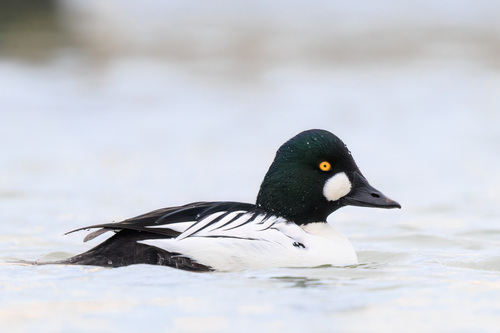
Common Goldeneye
The Common Goldeneye (Bucephala clangula) is a striking medium-sized sea duck known for its vibrant yellow eye, which is particularly prominent in the males. These ducks are expert divers, feeding on a variety of aquatic invertebrates, fish, and plant matter. They play an important role in their ecosystems, both as predators and as prey for larger animals. Common Goldeneyes are cavity nesters, often utilizing tree hollows or nest boxes, and are widespread across the northern hemisphere. They are not typically considered to have major cultural significance, but their distinctive appearance and behavior make them a favorite among birdwatchers.
42-50 cm
Length
65-80 cm
Wingspan
Least Concern
Conservation Status
Distribution
Common Goldeneyes breed across the boreal forests of Canada, Alaska, Scandinavia, and Russia. During the winter, they migrate south to coastal waters and ice-free lakes and rivers throughout North America, Europe, and Asia. Their altitudinal range extends from sea level to higher elevations in mountainous regions where suitable lakes are found.
Lifespan
The average lifespan in the wild is not well-documented, but they can live up to 10-12 years, and potentially longer in captivity.
Common Goldeneye's Habitat
Habitat Types
Boreal forests, Lakes, Rivers, Coastal waters, Estuaries
Climate Zones
Temperate, Boreal, Subarctic
Adaptations
Common Goldeneyes are well-adapted to cold environments. Their dense plumage provides excellent insulation, and their diving abilities allow them to access food sources beneath the ice. They have specialized salt glands to excrete excess salt when inhabiting marine environments.
Variations
Two subspecies are generally recognized: *Bucephala clangula clangula* (Eurasia) and *Bucephala clangula americana* (North America). The North American subspecies is sometimes considered slightly larger, but differences are subtle.
Appearance
Breeding Plumage
Breeding males have a striking black and white plumage with a distinctive white crescent-shaped patch between the eye and bill. Females and non-breeding males are primarily gray-brown with a white neck ring and a smaller white patch on the wing.
Seasonal Feather Changes
Males undergo an eclipse plumage after breeding, resembling the female's plumage but retaining some white wing patches.
Sex Based Plumage Differences
Strong sexual dimorphism. Males have bold black and white patterns, while females are more cryptic gray-brown.
Notable Features
Bright yellow eye (especially in males), White crescent-shaped patch on the face (males), Large, rounded head
Diet and Feeding
Primary Foods
Aquatic invertebrates, Crustaceans, Mollusks, Small fish, Aquatic plants, Seeds
Foraging Behavior
Common Goldeneyes are diving ducks, typically foraging in relatively shallow water. They dive underwater to search for prey, propelling themselves with their feet.
Specializations
Their strong diving ability and underwater agility are key specializations for their feeding habits. They can remain submerged for a significant amount of time.
Seasonal Diet Variations
Diet varies seasonally depending on prey availability. During the breeding season, they may consume more insects and larvae, while in winter, they may rely more on crustaceans and mollusks.
Behavior
Social Structure
Common Goldeneyes are generally gregarious, especially during migration and winter, forming large flocks. During the breeding season, they are more territorial.
Communication
Vocalizations (grunts, whistles, and croaks), Visual displays (head-throwing, wing-flapping)
Migration
Common Goldeneyes are migratory, moving south from breeding grounds to ice-free areas for the winter. They often follow coastlines and major river systems.
Territorial or Group Behaviors
During the breeding season, males defend territories around nesting sites. Outside of the breeding season, they are generally non-territorial and form large flocks.
Conservation
Threats
Habitat loss (deforestation and wetland drainage), Pollution (oil spills, pesticides), Climate change (altering breeding and wintering habitats), Hunting (in some regions)
Protection Programs
Nest box programs (to provide artificial nesting sites), Wetland conservation and restoration efforts, International treaties (Migratory Bird Treaty Act)
Local National Laws
Protected under various national and international laws, including the Migratory Bird Treaty Act in North America and similar legislation in Europe and Asia.
Population Trend
Stable
Population Estimates
The global population is estimated to be between 2.7 and 4.7 million individuals.
Interesting Facts
They are known for their fast and agile flight.
Their rapid wingbeats produce a characteristic whistling sound, giving them the nickname 'whistlers' in some regions.
Ducklings are precocial.
They can swim and dive shortly after hatching.
They often reuse nest sites year after year.
This makes nest box programs particularly effective for this species.
The Common Goldeneye is one of the latest ducks to migrate north in the Spring.
They wait until the ice has melted.
Faqs about Common Goldeneye
What is the difference between a male and female Common Goldeneye?
Males have a striking black and white plumage with a white crescent-shaped patch on their face, while females are mostly gray-brown.
Where do Common Goldeneyes nest?
They nest in tree cavities or nest boxes, often near water.
What do Common Goldeneyes eat?
They eat a variety of aquatic invertebrates, small fish, and plants.
Are Common Goldeneye endangered?
No. They are listed as Least Concern by the IUCN.
How deep can a Common Goldeneye dive?
They can typically dive to depths of up to 4 meters (13 feet), but they are capable of diving deeper if necessary.
Copyright @ Nature Style Limited. All Rights Reserved.
 English
English